 The picture from http://www.leeandlow.com/p/administrators_meiarticle.mhtml
The picture from http://www.leeandlow.com/p/administrators_meiarticle.mhtmlI would like to research into teaching cultures using the multicultural literature. Teachers use children’s literature such as storybooks in their English class, because those texts are familiar to young students and have rich vocabularies. They are not too much difficult and just right level. Some storybooks contain various cultures. Because of this, they are called ‘multicultural literature’. Students will learn various cultures together when they learn English with it. That is the reason why I choose the multicultural literature.
.
I will dig out various multicultural literature and research how to apply those materials concretely in the real English class. Problem-posing method is good to teach multicultural literature, some books of which are very unfamiliar and I need to localize them for young EFL learners, like changing contents or adding some supporting materials.
My rough sub topics are followed;
- Culture in Foreign English Language Teaching and Learning
- Teaching English in Korea
- Understanding Multicultural Children’s Literature
- Problem-posing with Multicultural Literature in the young EFL class room
- Integrated Lesson Plans to localize Multicultural Stories


